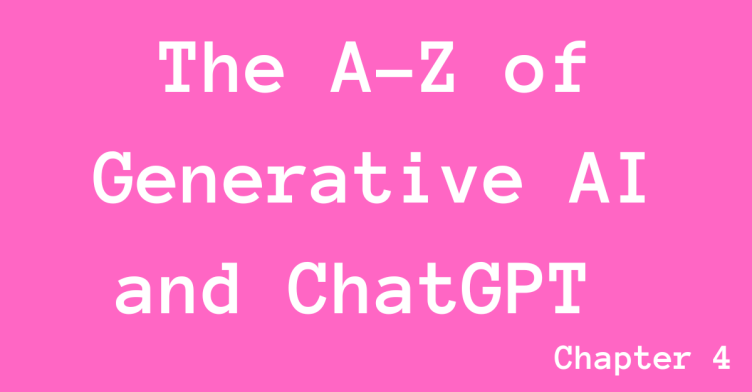The A-Z of Generative AI and ChatGPT – Chapter 4
Hardly a day goes by without some new Generative AI development surfacing in the media. CEOs have a tough but crucial role in understanding the signal from the noise to capture significant value for their enterprises by investing in the right Generative AI technologies.
With Generative AI being one of the fastest-growing technology categories ever, business leaders cannot afford to delay defining and shaping their enterprises Generative AI strategy.
If businesses are not already investing in developing AI super powers, they can be certain that their competitors already are.
Business leaders need to run simply to keep up. This series helps everyone learn what they need to know about Generative AI to stay ahead.
Enjoy.

Welcome to the A-Z of Generative AI where each week I will give you an explanation of every aspect of this exciting new technology beginning with the letter A and ending with the letter Z. You will learn all there is to know about Generative AI in this series to rapidly level up your job prospects, your productivity, and your business.
Each article will clearly explain Generative AI terms so you can master this hot technology. You will go from ZERO to HERO in a matter of weeks catapulting your knowledge and job prospects into a whole new stratosphere.
I will give you links to the very best Generative AI content on the planet.
Each item has been carefully selected and curated for your benefit.
I will also provide you with example prompts to hyperscale your productivity.
And give you links to the very best consulting companies’ articles on Generative AI for FREE as well.
And I will also give you my and other experts’ perspectives on how Generative AI will fundamentally change the world of work as you know it.
Don’t miss out.
Grab a lifetime of learning in the fastest time possible and start reading.

Generative AI, a subset of AI, has generated more interest than the launch of the iPhone and the World Wide Web combined in a much shorter time. For example, it took ChatGPT less than 5 five days to get a million users and reached 100 million users just two months after launching.
Why is Generative AI causing such excitement❓
Because of its transformative potential. And I don’t just mean its ability to help save lives, provide real-time personalisation and conversation, predict significant events, and more from data. Traditional AI models could already do that.
Traditional AI is narrow. It performs a single or specific task, such as processing a customer churn model.
In comparison, Generative AI is broad and can generate new images, music, speech, code, video, or text.
It is a technology that people are excited to use as it enables them to search, work, learn, and engage in a human-like way that is more productive and creative.
In addition, having API or screen-based access to large ‘out-of-the-box’ pre-trained foundational Large Language Models (LLMs) has opened affordable access to AI to the masses. Google, Bing, Bard, Meta, OpenAI and others have spent billions of dollars training foundational models so you don’t have to.
This is extraordinary as it enables businesses to benefit from a low-margin cost structure that can now leveraged to get more of their work done. And they are doing so at an almighty pace since the releases of ChatGPT.

With LLMs openly available businesses can now focus on developing ‘last mile’ Generative AI technology applications or use cases with the largest upfront cost already borne by others e.g., OpenAI
Where prior automation technology focused on physical work, the explosion in Generation AI means that the automation of knowledge work is now in ‘affordable’ sight.

Professionals in fields such as translation, creative writing, marketing, law, technology, health and the customer service industries are likely to see significant parts of their jobs automated sooner than anyone previously expected.
We are entering a new era of software and business – Intelligence 2.0 – where Generative AI’s capabilities and applications are limited only to our imaginations. If you can think it and describe then Generative AI can (or will) be able to create it.
The practical implications and applications of Generative AI are exciting the business world. It has immense potential to revolutionize any field where creativity and innovation are key which is a very different business shift than ever before.
Now that is exciting.

Wow, a very comprehensive must read that gets to the heart of Generative AI. If this doesn’t kick start an organization to take this seriously, or a career opportunity for those on the fence, nothing will.
You should break-out of this article about what you care about first and “get on it” and then, as you progress, use this content to sanity check when you overlook or where you might want to divest from the norm.
Gen AI is beyond disruptive and whilst caution should be the overarching theme for you, it must NOT stand in your way.
Francis Carden, Automation and AI thought leader, CEO, Automation Den Inc.

A digital revolution was already underway. Now this has been turbocharged with the release of Generative AI. We no longer need to be data or computer scientists to change the world. Generative AI has changed the very nature of how businesses operate and deliver value. It can ‘generate’ text, speech, images, music, video, and computer code in response to a command.
When that capability is joined with a business’s own proprietary information then how businesses make money dramatically changes. Generative AI will drive efficiency and innovation across all industries at scale. What ChatGPT can enable will be greater than any existing software produced to date.

How should CIOs, CEOs and CEOs respond to this ‘goose-bump technology?
There are 11 answers:
- Communicate the company’s stance: Quickly establish the company’s stance toward adopting Generative AI and communicate it clearly to employees. This is a transformative technology but care needs to be taken as it is rolled out to every role in the business.
- Identify business opportunities: Identify ways to use Generative AI to massively improve business productivity, growth, and create new business models or architectures. Generative AI enables the creation of new operations models and architectures including new digital, business, and resource architectures. Its potential is far, far greater than simply adding Generative AI to a conversational AI platform. Big thinking is required and that means the board and c-suite need to be involved at every step of the journey toward a generative enterprise.
- Have the CFO build the business case for Generative AI after you have experimented with this AI technology. Don’t try to do that day 1 as this will kill experimentation. This technology needs to be experimented with, and then a robust financial costs and benefits model can be built when you understand the art to the possible with Generative AI much better.
- Build Generative AI capabilities e.g., hire data scientists, MLOps engineers, enterprise architects, software developers, ML engineers to fine-tune models, business analysts, intelligent automation engineers, and database business administrators to name but a few roles. Invest quickly and move rapidly as your competitors are already experimenting with this technology. Proficiency does not end at hiring – ensure that career pathing in place to develop and grow talent as everyone will quickly fight for Generative AI talent like they have never done before.
- Deliver an education program across the enterprise starting at the board and executive team so everyone knows what’s possible and expected of them. Invest in upskilling key leaders with the skills and understanding they need first, then train the broader workforce, tailoring training programs by roles and proficiency levels.
- Build a prompt library that ever member of the business can access to help kick start their ability to generative value faster.
- Upgrade or build the enterprise technology architecture needed to integrate and manage Generative AI models. Develop a data architecture to enable access to quality data from structured and unstructured sources.
- Create a centralized team to own and govern approved Generative AI models to product and application teams on demand and have it report to the executive leadership team. Businesses saw, when establishing Robotic Process Automation (RPA) and Intelligent Automation programs, they needed a Centre of Expertise to govern and grow automation. Don’t make the mistake of leaving people to work this AI technology out for themselves.
- Evaluate the new risk landscape and establish ongoing mitigation practices for models, data, and policies. Generative AI presents a fresh set of compliance, business, data privacy, intellectual property, and ethical risks. This does not mean you hold back – invest quickly. But do establish a governance framework to ensure that the responsible use of Generative AI – including transparency, accountability, and fairness – happens under your guidance.
- Incentivise and reward the use of Generative AI in the business e.g., make its effective use part of everyone’s objectives / KPIs, have each executive own a Generative AI value stream and report progress to their peers monthly, bonus its impact, and finally place the best employees in Generative AI expanding roles to show how important this is.
- Collaborate with industry partners, academia, and government agencies to advance the development and adoption of generative AI.
Keen to learn more❓ Then keep reading.

Need someone to look at every role in your business and tell you how to use Generative AI to maximise business outcomes ❓
Then book a FREE 30 minute introductory call so we can discuss your specific business’s, Data Analytics, Artificial Intelligence, Generative AI needs – click here.

1. Data Augmentation in Generative AI 🅳
Data Augmentation in Generative AI involves enhancing the diversity and quantity of training data to improve the AI model’s performance. Like a photographer using different angles and lighting to capture stunning images, data augmentation introduces variations to the existing data, enabling the model to learn from a broader range of examples.
For example, an autonomous vehicle company could employ Data Augmentation in Generative AI to train its driving model. By introducing various weather conditions, road types, and traffic scenarios, the AI model becomes more robust and capable of handling diverse real-world driving situations.
- Prompt: “Use Data Augmentation in Generative AI to improve our customer feedback sentiment analysis. Introduce variations in the phrasing and structure of customer reviews to enhance the AI model’s understanding and accuracy.”
2. Deep Learning in Generative AI 🅳
Deep Learning forms the backbone of Generative AI, where complex neural networks are used to learn patterns and generate content. Similar to how a musical prodigy learns to play multiple instruments, deep learning models master intricate representations to generate diverse and high-quality content.
For example, a music production company might use Deep Learning in Generative AI to create personalized soundtracks for videos. The AI model analyses video content, extracting relevant emotional cues, and generates matching musical compositions to evoke specific moods.
- Prompt: “Utilize Deep Learning in Generative AI to compose a series of background music tracks for our advertising videos. The AI model should understand the content’s context and generate suitable tunes to amplify the video’s impact.”
3. Differentiable Programming in Generative AI 🅳
Differentiable Programming allows AI models to incorporate custom functions and constraints directly into the training process. Like an agile dancer adapting movements seamlessly, this approach enables AI models to optimize content generation while adhering to specific rules or guidelines.
For example, a graphic design agency might use Differentiable Programming in Generative AI to create customized logos. The AI model considers design principles and branding guidelines while generating unique logos that align with clients’ requirements.
- Prompt: “Apply Differentiable Programming in Generative AI to design a series of logo concepts for our new product line. Incorporate specific color schemes and design elements to ensure the generated logos adhere to our brand guidelines.”
4. Domain Adaptation in Generative AI 🅳
Domain Adaptation in Generative AI focuses on adapting AI models to perform effectively in different target domains. Like a multilingual translator who effortlessly switches between languages, domain adaptation equips AI models to transfer their knowledge from one domain to another seamlessly.
For example, a healthcare organization could employ Domain Adaptation in Generative AI to diagnose medical conditions from different hospitals’ datasets. The AI model learns from diverse patient data and adapts its diagnosis capabilities to new medical facilities.
- Prompt: “Demonstrate Domain Adaptation in Generative AI by generating personalized financial reports for various customer segments. Train the AI model on data from different customer groups and ensure it adapts to each group’s specific financial needs.”
5. Diverse Sampling in Generative AI 🅳
Diverse Sampling in Generative AI aims to produce varied and distinctive outputs, avoiding repetitive or similar content. Like a creative chef concocting diverse dishes, diverse sampling encourages AI models to generate unique and innovative content.
For example, a content creation agency could use Diverse Sampling in Generative AI to develop a series of unique social media posts for a marketing campaign. The AI model ensures each post has a distinct tone and message, attracting different segments of the target audience.
- Prompt: “Employ Diverse Sampling in Generative AI to design a set of creative advertising headlines for our product launch. Ensure each headline offers a fresh and captivating perspective on the product’s benefits.”

This article is sponsored by Docparser – the cloud based parsing experts.

Docparser is a secure cloud-based document data extraction solution that helps businesses of all sizes retrieve data from PDFs, Word docs, image files and more.
📽️ 📻 Revolutionize Document Processing: How Docparser Transforms Your Business Efficiency
Docparser caters to industries including manufacturing, logistics, wholesale, accounting, retail, hospitality and more. The platform helps users with accounts and invoice payable processing, purchase and sales orders, delivery notes, standardized contracts, agreements, price lists, bank statements and HR forms.
📕 It’s time to get very excited about boring AI – Kieran Gilmurray
Docparser integrates with Dropbox, Microsoft, Box, Zapier, Salesforce CRM, Workato, Rest API and Webhooks, Docparser is priced on a monthly or annual subscription and support is extended via email and documentation.
📽️ Revolutionizing Logistics: The Power of AI-Driven Data Extraction & Automation
🙋♂️ Try Docparser for free today and see the results for yourself.
6. Domain-Specific Generative AI Models 🅳
Domain-Specific Generative AI Models are designed to excel in specific industries or niches. Similar to a specialized expert in a particular field, these models possess domain knowledge that enables them to produce highly relevant and accurate content.
For example, a legal firm might implement Domain-Specific Generative AI Models to draft legal contracts. The AI system is trained on vast legal databases, generating precise and tailored contracts for various legal scenarios.
- Prompt: “Develop a Domain-Specific Generative AI Model for our architecture firm. Train the AI model on architectural design principles and construction regulations to generate accurate and compliant building blueprints.”
7. Dynamic Output Modification 🅳
Dynamic Output Modification in Generative AI allows real-time adjustments to generated content based on user feedback or requirements. Like a flexible actor adapting performances to audience reactions, dynamic output modification ensures that AI-generated content remains relevant and aligned with user preferences.
For example, a language translation service might deploy Dynamic Output Modification in Generative AI to improve translation accuracy. The AI model refines translations based on user feedback, continuously enhancing the quality of translated text.
- Prompt: “Demonstrate dynamic output modification in your responses to customer inquiries. Adapt your answers based on user feedback, ensuring accurate and relevant information for each interaction.”
8. Data-Driven Decision Making with Generative AI 🅳
Data-Driven Decision Making harnesses the power of Generative AI to analyze vast datasets and provide valuable insights for strategic choices. Like a seasoned detective gathering clues to solve a case, Generative AI extracts patterns and trends from data, supporting informed and impactful decision-making.
For example, a retail company could employ Data-Driven Decision Making with Generative AI to optimize inventory management. The AI system analyzes historical sales data, predicting demand fluctuations, and guiding inventory restocking to minimize stockouts and overstocking.
- Prompt: “Use Data-Driven Decision Making with Generative AI to analyze customer feedback and recommend improvements to our customer support process. Provide insights on potential service enhancements based on customer sentiments and feedback trends.”
9. Disentangled Representations in Generative AI 🅳
Disentangled Representations in Generative AI enable the separation of different factors within content generation. Similar to organizing a wardrobe with distinct compartments for various clothing items, disentangled representations allow AI models to control and manipulate specific features independently.
For example, a virtual fashion designer could utilize Disentangled Representations in Generative AI to customize clothing designs. The AI model separates garment styles, colours, and patterns, enabling users to mix and match various design elements.
- Prompt: “Demonstrate Disentangled Representations in Generative AI by creating a series of customizable car designs for our automotive company. Separate vehicle body shapes, colours, and accessories, allowing customers to personalize their ideal car.”
11. Diagnostics and Error Analysis in Generative AI 🅳
Diagnostics and Error Analysis in Generative AI involve identifying and understanding the model’s mistakes to improve its performance. Like a detective analysing clues to solve a mystery, this process helps AI developers fine-tune their models and reduce errors.
For example, an online language learning platform might employ Diagnostics and Error Analysis in Generative AI to enhance speech recognition. By analysing misinterpreted words and patterns in user speech, the AI model refines its pronunciation accuracy.
- Prompt: “Conduct diagnostics and error analysis to improve your responses to legal queries. Identify common misunderstandings and ambiguities in legal language, ensuring accurate and contextually appropriate answers.”
12. Deployment in Generative AI 🅳
Deployment in Generative AI refers to the process of integrating AI models into real-world applications. Like launching a rocket into space, successful deployment ensures that AI models work effectively and efficiently in practical scenarios.
For example, a virtual reality gaming company might undertake Deployment in Generative AI to create lifelike environments. The AI model generates realistic landscapes and scenarios that immerse players in thrilling gaming experiences.
- Prompt: “Prepare for deployment as a virtual assistant in our customer service department. Integrate with our communication systems to provide real-time support and assistance to customers.”
Understanding the A-Z of Generative AI opens up a rich world of possibilities for business leaders. These concepts provide valuable insights into how AI can create new content, solve problems, and drive innovation across various industries.
Embracing Generative AI can lead to enhanced creativity, improved decision-making and a competitive edge in the rapidly evolving data infused digital landscape.
Next in our series is chapter E – it will be released next week.
If you missed any of the prior chapters then here are links to them:
📕 A-Z Of Generative AI and ChatGPT – Chapter A











Leave a Reply